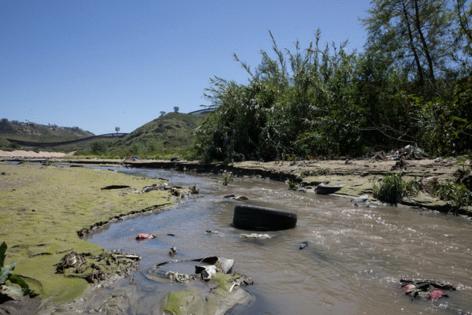Another survey spotlights how the sewage crisis has affected the Tijuana River Valley's quality of life
Published in News & Features
People who live, work or visit communities near the Tijuana River Valley, where untreated wastewater spills over from Mexico, attribute their worsening physical and mental health issues to the cross-border pollution, a federal survey about the sewage crisis found.
County public health officials on Tuesday released the findings on behalf of the federal Agency for Toxic Substances and Disease Registry, which made its online survey available from Oct. 21 through Nov. 22, 2024. More than 2,000 people from Coronado, Imperial Beach, Nestor, Otay Mesa West, San Ysidro and Silver Strand responded.
The survey, called an Assessment for Chemical Exposures or ACE, follows a similar survey the Centers for Disease Control and Prevention launched in October, which also highlighted the severe effect of the crisis on daily life and health. The CDC’s randomized, in-person survey captured data from a much smaller sample.
But both document what residents and workers have said for years: the ongoing pollution is affecting their quality of life.
“To repeat results or findings from an expanded pool of people, from over 2,000 people filling out the survey, I think it’s still eye-opening,” said county Public Health Officer Sayone Thihalolipavan. “I hope that kind of shock value does not get lost because this is important, right, to see that the community’s concerns … are validated.”
According to the survey, 64% of people experienced at least one new or worsening physical health symptom they attributed to cross-border pollution exposure. The most common were headaches, runny noses and congestion. Increased tearing, burning noses and throats and itchy skin were also mentioned.
More than 400 individuals said they sought medical care because of sewage-linked symptoms. Of them, 72% said they saw a primary care doctor, 36% went to the hospital or emergency room and were released and 7% said they were admitted.
The county has been tracking trends of asthma, gastrointestinal illness and chronic obstructive pulmonary disease symptoms from emergency room departments to see if there are any concerning increases, but Thihalolipavan said Tuesday the county has not seen any changes.
Public Health officials said they have also invited local health care providers to share data they may be collecting that could indicate changes missed by the county’s syndromic surveillance. Thihalolipavan said there’s a systemic challenge in data collection for providers because there’s no medical code used to classify symptoms that patients in their care associate with the sewage crisis.
“The doctor might write in an open text field, but then it’s not like easily pullable data,” he said. “So it’s really hard to find that, or doctors may not write that in their notes, right? It’s hard to see those associations sometimes.”
Surveys like the ACE, Thihalolipavan added, help officials get a more “complete picture” of the crisis’ impact on people.
Most people said they do not believe the affected communities are safe to live in, work or visit. A majority also said they missed work or their child missed school or daycare due to symptoms they experienced that they believe are linked to the cross-border pollution. More than 20% said they had pets with health symptoms they also believed to be related to the sewage crisis.
On mental health, 65% said they felt that their mental health suffered because of the sewage crisis. Nearly 30% reported anxiety and 21% reported depression. Rates were higher among individuals who also reported severe sewage odors. And results also showed that the more frequently the stench was reported, the more severe the odor was.
County officials had anecdotal information that people in the affected communities did not trust their tap water. They were caught off guard by the figures in the CDC survey, which found that 71% of households believed their tap was unsafe to consume. The ACE revealed the same thing: 86% were concerned about the quality of their tap water, and 70% of their primary source of drinking water was bottled water.
“People are spending money and time unnecessarily that they could be using for other things in their lives and that really needs to be addressed,” said Mark Beatty, county assistant medical director.
Last year, upon learning about drinking water concerns, the county wrote a letter to the California Environmental Protection Agency, requesting that the state Water Resources Control Board test drinking water more frequently. In its response to the county, the state agency tried to dispel concerns that the water is sourced locally from wells or the polluted Tijuana River and noted that water sources for Imperial Beach, for example, “are many miles removed” and undergo extensive treatment. Imperial Beach’s potable water is supplied by California American Water, which buys treated surface water from the city of San Diego.
Thihalolipavan said that “there’s still work to be done from the water agencies” to remind the public that their tap water is safe. “So, we need to continue to push on them (the agencies) right, and show them this data (ACE results),” he added.
Since the CDC’s survey was released, Public Health officials said they continue to monitor health symptoms and water and air quality in collaboration with multiple state and federal agencies, as well as promote mental health resources. They are also asking government officials for expanded support. For example, the county recently renewed its plea to the governor that he reconsider declaring the sewage crisis an emergency. An answer is pending.
One other effort underway is a public health assessment by the Agency for Toxic Substances and Disease Registry, which is reviewing data on hydrogen sulfide, surface water, sediment, soil, fish tissue and odor complaints “collected by government agencies and researchers to evaluate past, current, and potential future exposures.”
The two-part assessment is expected to produce an air-related report next year, followed by another on exposure pathways, such as water and sediment. The agency will issue recommendations to reduce or prevent harmful exposure based on its findings.
_____
©2025 The San Diego Union-Tribune. Visit sandiegouniontribune.com. Distributed by Tribune Content Agency, LLC.







Comments